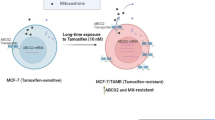Abstract
In this study, we established two PTX-resistant breast cancer cell lines, 231 TIM10 and MCF-7 TIM10, from ER-negative MDA-MB-231 cells and ER-positive MCF-7 cells by pulse selection, respectively. We found that 231 TIM10 variants acquired higher drug resistance than MCF-7 TIM10 variants by the pulse selection, although ER-positive MCF-7 cells were not as sensitive as ER-negative MDA-MB-231 to the initial pulses with PTX. 231 TIM10 had 11.9-fold greater resistance (RI = 11.9) than the parental MDA-MB-231 cells, while MCF-7 TIM10 got 5.5-fold resistance (RI = 5.5) when compared with the parental MCF-7 cells. In the presence of 5nM PTX, 231 TIM10 cells formed colonies, but no colony formed when MCF-7 TIM10 cells were cultured in the same condition. These data have two implications. First, the ER expression state might be an important determinant for the response of breast cancer cells to paclitaxel treatment. Second, ER-negative and ER-positive breast cancer cells develop drug-resistance phenotype with distinctive mechanisms. Our work not only established useful models for studying the paclitaxel resistance but also provides interesting clues to understand the mechanisms underlying the drug resistance of ER-negative and ER-positive breast cancer cells.






Similar content being viewed by others
References
Gluz O, et al. Triple-negative breast cancer—current status and future directions. Ann Oncol. 2009;20(12):1913–27.
Rose AA, Siegel PM. Breast cancer-derived factors facilitate osteolytic bone metastasis. Bull Cancer. 2006;93(9):931–43.
Hassan MS, Ansari J, Spooner D, Hussain SA. Chemotherapy for breast cancer (Review). Oncol Rep. 2010;24:1121–31.
Martinez VG, O’Connor R, Liang Y, Clynes M. CYP1B1 expression is induced by docetaxel: effect on cell viability and drug resistance. Br J Cancer. 2008;98(3):564–70.
Lee DH, et al. Proteomic identification of paclitaxel-resistance associated hnRNP A2 and GDI 2 proteins in human ovarian cancer cells. J Proteome Res. 2010;9(11):5668–76.
Cheung CH, et al. Cancer cells acquire mitotic drug resistance properties through beta I-Tubulin mutations and alterations in the expression of beta-tubulin isotypes. PLoS One. 2010;5(9):e12564.
Berry DA, et al. Estrogen-receptor status and outcomes of modern chemotherapy for patients with node-positive breast cancer. JAMA. 2006;295:1658–2356.
Group EBCTC. Effects of chemotherapy and hormonal therapy for early breast cancer on recurrence and 15-year survival: An overview of the randomised trials. Lancet. 2005;365:1687–717.
Barrios CH, Sampaio C, Vinholes J, Caponero R. What is the role of chemotherapy in estrogen receptorpositive, advanced breast cancer? Ann Oncol. 2009;20:1157–62.
Sui M, Huang Y, Park BH, Davidson NE, Fan W. Estrogen receptor alpha mediates breast cancer cell resistance to paclitaxel through inhibition of apoptotic cell death. Cancer Res. 2007;67(11):5337–44.
Tabuchi Y, et al. Resistance to paclitaxel therapy is related with Bcl-2 expression through an estrogen receptor mediated pathway in breast cancer. Int J Oncol. 2009;34:313–9.
Foulkes WD, et al. Triple-negative breast cancer. N Engl J Med. 2010;363:1938–48.
Liedtke C, et al. Response to neoadjuvant therapy and long-term survival in patients with triple-negative breast cancer. J Clin Oncol. 2008;26:1275–81.
Carey LA. Directed therapy of subtypes of triple-negative breast cancer. Oncol. 2010;15:49–56.
Nishimura R, Arima N. Is triple negative a prognostic factor in breast cancer. Br Cancer. 2008;15:303–8.
Kan N, Kuwata K, Mise K, Kodama H. Effective therapeutic regimens for patients with triple-negative (er/pgr/her2-negative) metastatic breast cancer. Gan To Kagaku Ryoho. 2010;37:1259–64.
Yang LY, Trujillo JM. Biological characterization of multidrug-resistant human colon carcinoma sublines induced/selected by two methods. Cancer Res. 1990;50:3218–25.
Glynn SA, et al. A new superinvasive in vitro phenotype induced by selection of human breast carcinoma cells with the chemotherapeutic drugs paclitaxel and doxorubicin. Br J Cancer. 2004;91(10):1800–7.
Brown I, et al. Reduced expression of p27 is a novel mechanism of docetaxel resistance in breast cancer cells. Br Cancer Res. 2004;6(5):601–7.
Gan Y, Wientjes MG, Lu J, Au JL. Cytostatic and apoptotic effects of paclitaxel in human breast tumors. Cancer Chemother Pharmacol. 1998;42:177–82.
Blagosklonny MV, Fojo T. Molecular effects of paclitaxel: myths and reality. Int J Cancer. 1999;83:151–6.
Giampietro G, et al. Randomized Phase II Trial of weekly paclitaxel alone versus trastuzumab plus weekly paclitaxel as first-line therapy of patients with Her-2 positive advanced breast cancer. Br Cancer Res Treat. 2007;101:355–65.
Perez EA. Paclitaxel in breast cancer. Oncol. 1998;3:373–90.
Campone M, et al. Safety and pharmacokinetics of paclitaxel and the oral mTOR inhibitor everolimus in advanced solid tumours. Br J Cancer. 2009;100:315–21.
Kwon YS, et al. Sensitive ChIP-DSL technology reveals an extensive estrogen receptor α-binding program on human gene promoters. PNAS. 2007;104(12):4852–7.
Shang Y, Hu X, DiRenzo J, Lazar MA, Brown M. Cofactor dynamics and sufficiency in estrogen receptor–regulated transcription. Cell. 2000;103:843–52.
Carroll JS, et al. Chromosome-wide mapping of estrogen receptor binding reveals long-range regulation requiring the forkhead protein FoxA1. Cell. 2005;122:33–43.
Lin CY, et al. Whole-genome cartography of estrogen receptor a binding sites. PLoS Genet. 2007;3(6):867–85.
Pradhan M, Bembinster LA, Baumgarten SC, Frasor J. Proinflammatory cytokines enhance estrogen-dependent expression of the multidrug transporter gene ABCG2 through estrogen receptor and NFκB cooperativity at adjacent response elements. JBC. 2010;285(41):31100–6.
Frasor J, et al. Profiling of estrogen up- and down-regulated gene expression in human breast cancer cells: insights into gene networks and pathways underlying estrogenic control of proliferation and cell Phenotype. Endocrinology. 2003;144(10):4562–74.
Dalvai M, Bystricky K. Cell cycle and anti-estrogen effects synergize to regulate cell proliferation and ER target gene expression. PLoS One. 2010;5(6):e11011.
Ohta T, et al. Contemplating chemosensitivity of basal-like breast cancer based on BRCA1 dysfunction. Br Cancer. 2009;16:268–74.
Edwards SL, et al. Resistance to therapy caused by intragenic deletion in BRCA2. Nature. 2008;451:1111–6.
Skog S, He Q, Khoshnoud R, Fornander T, Rutqvist LE. Genes related to growth regulation, DNA repair and apoptosis in an oestrogen receptor-negative (MDA-231) versus an oestrogen receptor-positive (MCF-7) breast tumour cell line. Tumor Biol. 2003;25:41–7.
Acknowledgments
This work was supported by The National Natural Science Foundation of China (Grant 30870978).
Author information
Authors and Affiliations
Corresponding author
Rights and permissions
About this article
Cite this article
Ying, W., Wang, S., Shi, J. et al. ER−/ER+ breast cancer cell lines exhibited different resistance to paclitaxel through pulse selection. Med Oncol 29, 495–502 (2012). https://doi.org/10.1007/s12032-011-9889-9
Received:
Accepted:
Published:
Issue Date:
DOI: https://doi.org/10.1007/s12032-011-9889-9




